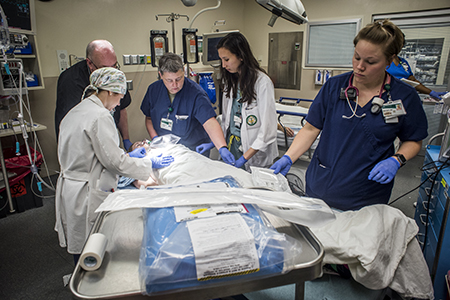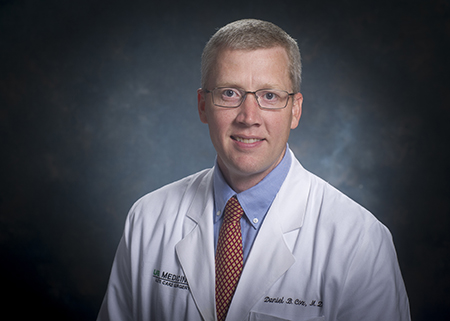University of Alabama at Birmingham The use of whole blood rather than component blood products has been driven by military experience in battlefield medicine. Hospital is among the first medical centers in the nation to switch to administering whole blood during transfusions for patients with severe trauma rather than component blood products. The switch is driven by recent experience gained in battlefield medicine by the United States military.
The use of whole blood rather than component blood products has been driven by military experience in battlefield medicine. Hospital is among the first medical centers in the nation to switch to administering whole blood during transfusions for patients with severe trauma rather than component blood products. The switch is driven by recent experience gained in battlefield medicine by the United States military.
Large-scale blood transfusion got its start during World War II as medical providers attempted to treat the large number of wounded. Blood banking developed after the war as a means of providing blood products for civilian use following severe injury. To better manage the perishable blood supply, blood banks would break a unit of blood into three components — packed red blood cells, platelets and FFP, or fresh frozen plasma, which contains clotting factors.
“In trauma care, the standard for the past 40 years or so has been to give packed red blood cells and IV fluids for patients in need of an emergency transfusion, followed by small amounts of FFP and perhaps platelets later,” said Daniel Cox, M.D., the trauma medical director in the Division of Acute Care Surgery, Department of Surgery. “That thinking has changed based on advances in battlefield medicine honed during conflicts in the Middle East.”
During the Iraq war, field experience showed that giving all three component parts in equal measure led to better outcomes for wounded war fighters. Civilian hospitals began to adopt that strategy in the early 2000s.
Cox, who served as an Air Force surgeon for eight years with deployments to combat zones in the Middle East, says the logistics of managing FFP and platelets in the field can be challenging.
“You need an advanced blood banking facility to effectively manage those components, and that is very difficult to do in the field, especially in far-forward areas in austere conditions,” he said. “The military solution was to simply transfuse whole blood from a donor directly to the casualty.”
Cox says the outcomes were remarkable.
| “We’ve been able to leverage our relationship with our military connections to be at the forefront of bringing this type of lifesaving initiative to our patients in Alabama.” |
“It was rapidly recognized that outcomes improved,” Cox said. “A patient who is actively bleeding is bleeding whole blood, so it stands to reason that they need whole blood with all of its components in the transfusion. We found that it was the ideal way to resuscitate a wounded patient.”
UAB is home to Air Force Special Operations Surgical Teams, who work and train at UAB when not deployed overseas. The SOST’s also have experience using whole blood in the field and, along with Cox, brought the concept to UAB.
The UAB Trauma Center began using whole blood in early August for patients with massive bleeding from severe trauma, one of only about 20 civilian hospitals in the nation doing so.
The program partners with UAB Transfusion Services and the American Red Cross.
 Daniel Cox, M.D., the trauma medical director in the Division of Acute Care Surgery“We worked with the Red Cross for about a year to fine-tune the plans and establish the appropriate protocols to make whole blood donation work,” said Marisa Marques, M.D., medical director of UAB Transfusion Services and a professor in the Department of Pathology.
Daniel Cox, M.D., the trauma medical director in the Division of Acute Care Surgery“We worked with the Red Cross for about a year to fine-tune the plans and establish the appropriate protocols to make whole blood donation work,” said Marisa Marques, M.D., medical director of UAB Transfusion Services and a professor in the Department of Pathology.
UAB receives whole blood from a Red Cross facility in Oklahoma. Whole blood units have a shelf life of 21 days and do not require special handling or storage. According to Food and Drug Administration requirements, whole blood units must be O positive or O negative with low titers of anti-A and anti-B so they can be transfused to nearly any patient.
“In July, we had 15 trauma cases where whole blood would have been warranted,” Cox said, “so we anticipate that we’ll be using it every other day or so going forward.”
The use of whole blood should produce higher survival rates for those with severe injuries due to quicker bleeding control, which should also reduce the amount of blood products needed. Blood of all types is often in short supply, especially in summer.
“Use of whole blood might also be appropriate in other surgical fields where blood loss is an issue, particularly in cardiothoracic surgery and OBGYN,” Marques said.
“Many of the innovations in civilian trauma care were pioneered through military medicine,” Cox said. “At UAB, we’ve been able to leverage our relationship with the Air Force SOST’s and other military connections to be at the forefront of bringing this type of lifesaving initiative to our patients in Alabama.”